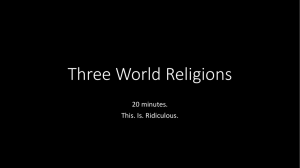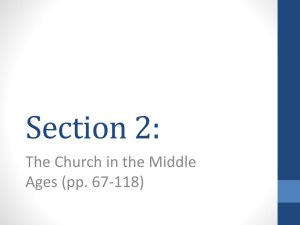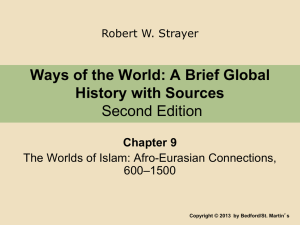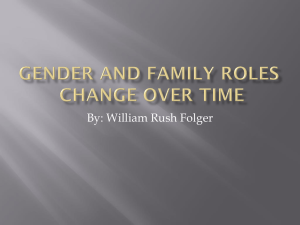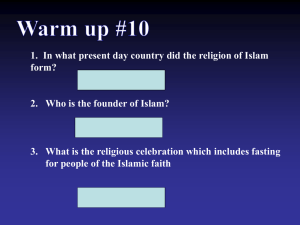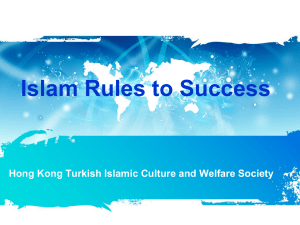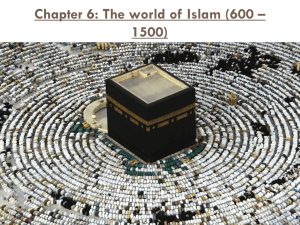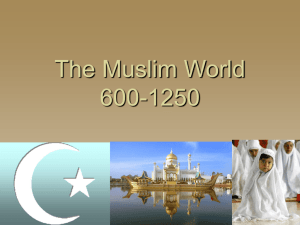CHAPTER 5 Light In The Dark Ages Throughout all of the insecurity
advertisement
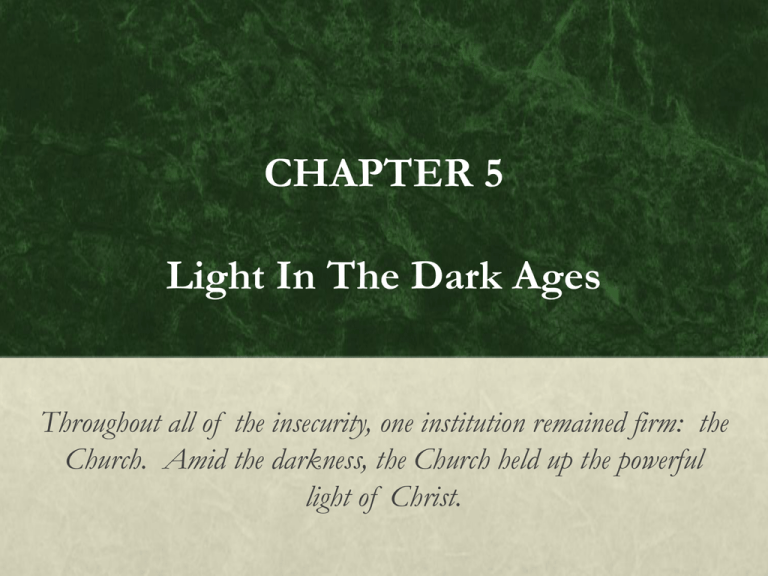
CHAPTER 5 Light In The Dark Ages Throughout all of the insecurity, one institution remained firm: the Church. Amid the darkness, the Church held up the powerful light of Christ. CHAPTER 5 Light In The Dark Ages The collapse of the Roman Empire during the fifth century inaugurated a period of decline in the West. Although insecurity and confusion reigned, one institution remained firm: the Church. The Church continued its mission and provided continuity. This Chapter looks at the fall of the Roman Empire, the rise and importance of monasticism, and the rise of Islam. PART I The Collapse of the Roman Empire The fall of the Roman Empire led to a crisis in the Church. It now had to disassociate itself from an Empire that it had assumed would last forever. Throughout the decline of the empire and the rise of monasticism, the Holy Spirit strengthened the Church for a new wave of evangelizing activity among the Germanic Tribes. By the eleventh century, Christianity had spread to virtually all parts of the European continent. THE FALL OF ROME (476) Although there is not an exact date for the fall of the Roman Empire, at some time during the fifth century the West collapsed. In AD 410, Alaric, the king of the Visigoths, sacked Rome, and, in AD 476, the last western emperor was overthrown. The moral situation was grim as the invading barbaric tribes injected a foreign and often violent character into the culture. The absence of academic pursuits among these tribes undermined the Greco-Roman tradition of learning and culture leading to a collapse in intellectual activity. THE FALL OF ROME (476) This affected the Church as now most people could no longer read the Bible. Academic training was limited to priests studying Scripture and theology. The economy declined, roads were unsafe, and people lived in fear and distress. The empire became a rural society of isolated towns and villages. The influence of the Church at that time was not sufficiently profound to impact the daily life of the whole population. The Church’s organization was based on that of the Roman Empire, and the Church had to adapt itself to a new cultural situation. THE GERMANIC TRIBES The mission of the Church involves not only Christianizing cultures, but at the same time adapting itself insofar as possible to these cultures. The Germanic tribes were the second largest Northern European group after the Celts. The Roman Empire had never been able to conquer these tribes in their own territory, and so had settled for defending the vast boundaries of the empire. The empire reached an agreement with many of the tribes along its border, and many of the Germanic peoples were conscripted into the army. In time, the Roman army itself became Germanized to such an extent that it was Roman in name only. THE GERMANIC TRIBES The Visogoths conquered the Iberian and Italian peninsulas. The Ostrogoths later replaced the Visogoths in Italy. The Franks settled in France and under the leadership of Clovis, became the first Germanic tribe to convert to Christianity AD 497. The Alemanni settled in Germany, Switzerland, and Alsace. The Burgundians established a capital in Worms. The Lombards lived along the Elbe, Danube, and eventually settled in Austria and Hungary. The Vandals were the most ruthless of the Germanic tribes, attacking Gaul and later moving on to Spain and Northern Africa. They were so fierce that the word “vandal” is still used in English today. They were also relentless persecutors of the Church. ULPHILAS: APOSTLE OF THE GOTHS Ulphilas (311-388) was captured by the Goths. Under the influence of an Arian bishop he translated the Bible into Gothic and was later made a bishop himself. Due to his missionary efforts, the Goths, Burgundians, Lombards, and Vandals were converted to Arian Christianity. THE HUNS The Huns, a powerful nomadic people, swept from northern China to the Volga valley in the fifth century. They soon established themselves in the eastern empire, exacting tribute from the emperor, and by AD 451 they had invaded Gaul and were threatening the heart of the Western Empire. They did not settle down to build houses or farms, and acquired a reputation as a fierce and ruthless people who devastated much of Europe. ATTILA THE HUN MEETS POPE ST. LEO THE GREAT (452) Attila (d. 453), “The Scourge of God,” successfully united the Huns under one rule. He was a brave warrior, a skilled diplomat, and a skilled military strategist. Earlier in his life he had been held a hostage in Rome where he learned Latin and discovered Rome’s weaknesses. He engaged the Romans and invaded Gaul, which he devastated. Finally, in AD 451, an allied Visogothic/Roman army defeated him and forced him back across the Rhine. ATTILA THE HUN MEETS POPE ST. LEO THE GREAT (452) Defeated in Gaul he turned toward Italy attacking the towns in the North. As he drew close to Rome, Pope St. Leo the Great went to meet him. Attila is said to have met a procession of priests, deacons, and acolytes singing hymns and psalms, followed by an old man sitting on a horse. When Attila asked his name the old man replied, “Leo the Pope.” No one knows what Pope St. Leo said to Attila, but Attila did not attack Rome and withdrew entirely from Italy. Pope St. Leo was not able to repeat the same success in AD 455 but was at least able to convince the leader of the Vandals, Genseric, not to burn Rome, and to spare the lives of the people. HISTORICAL INTERPRETATION OF THE GERMANIC INVASIONS Over time the Church developed several concrete ideas concerning the Germanic invasions: First, the Church recognized that Christianity was universal and needed to be communicated to the Germanic Tribes. The Church had adopted the governmental structures, customs, language, and laws of the Roman Empire, but now had to adapt to civilizing and evangelizing the Germanic Tribes. The Germanic peoples were not philosophical, nor theological, and placed less emphasis on order, culture, organization, and law. Much of what the Church had learned and developed had to be radically altered in order to work with the Germanic peoples without altering the essential doctrines of Christianity. Through monasticism, which had established itself firmly by the end of the fifth century, the Church gained access to these people. THE CHRISTIAN ATTITUDE TOWARD THE INVASIONS Initially, the Christians were discouraged with the fall of the Roman Empire. Many thought that the Second Coming of Christ was imminent. Others saw the Fall of the Empire as a punishment for the sins of the Romans. They pointed to the moral degradations of the Roman Empire, not to mention that of many Christians. Many left the moral deteriorations of the cities for a life of asceticism expressed in the evangelical counsels of poverty, chastity, and obedience. This radical separation from the world for the sake of Christ’s kingdom through prayer and penance characterized monasticism. PART II The Rise of Monasticism The First Appearance of Monasticism Monasticism is a way of life characterized by prayer and self-denial lived in seclusion from the world and under a fixed rule with professed vows. Christian monasticism is unique in that one seeks to model oneself on Christ by complete dedication to a life of prayer and penance. There are two types of monastic life: • The eremetical, or hermit life, involves loosely organized groups living an ascetical life. The word hermit comes from the Greek meaning “desert.” • The second type, and more common form, is the cenobitical, or common life; that is monastic life lived in a community. PART II The Rise of Monasticism The First Appearance of Monasticism While St. Paul of Thebes is considered to be the first hermit, St. Anthony indirectly influenced Western Monasticism through his impact on St. Athanasius, who wrote his biography. When St. Athanasius brought this book to Rome, it served as a handbook for Western Monasticism. Two monastic orders, the Carthusians and Carmelites, have taken much inspiration from the eremetical life. St. Pachomius (290-346) founded cenobitical monasticism in Egypt. Desiring to withdraw from the world he sought solitude in the desert, but as more people heard about his life of holiness, they sought him out to ask for his prayer and guidance. He allowed many to join him and wrote an early form of monastic rule. His rule influenced St. Basil the Great, St. John Cassian, and St. Benedict in their establishment of monastic orders. MONASTICISM AND THE EMERGENCE OF A NEW CHRISTIAN CULTURE The rise of monasticism proved vital for the spread of Christianity in three ways: They were a source of great spiritual strength; They served as seminaries for priests and bishops; They functioned as centers of evangelization for the barbarian tribes. As Europe became more agrarian, monastic communities spread into these areas to provide for the spiritual needs of the people. They helped establish new farmlands and farming communities. MONASTICISM AND THE EMERGENCE OF A NEW CHRISTIAN CULTURE The monasteries became the chief centers of learning until the rise of the universities. They copied and retained the literary works of the Greco-Roman world. Benedictine monasteries had a scriptoria set aside for copying texts. These monasteries single-handedly saved Western Culture during this period. Another effect was that of civilization. The Germanic tribes were attracted by their goodness and holiness and came to learn trades such as agriculture, carpentry, stone masonry, and ironwork. The monks also taught the people how to read and write, elevating the people intellectually. ST. BENEDICT: THE “PATRIARCH OF WESTERN MONASTICISM” St. Benedict left Rome withdrawing to a cave in Subiaco to live the life of a hermit. As word of his sanctity grew, others joined him. Eventually he went on to found twelve monasteries and placed a superior in each one. He began his thirteenth monastery at Monte Cassino AD 529. While there he composed his rule, now known as the “Rule of St. Benedict.” ST. BENEDICT: THE “PATRIARCH OF WESTERN MONASTICISM” His rule has been praised for its spirit of love and peace, as well as its moderation in the ascetical life. For example, his monks were to sleep between 6-8 hours each night, and were to have a bed, a pillow, and sufficient food. This is in contrast to Egyptian monasticism where a strict ascetical life included sleep deprivation and little food. The monastic life was to be lived in common, as a family and selfsustaining community. Each had different tasks, working for the good of the whole. No one was to have personal property, although the monastery might. Physical labor and prayer was a part of their daily routine. After their novitiate, the monks would profess vows of poverty, chastity, and obedience. THE RULE OF ST. BENEDICT The rule divided the day into two parts: prayer and work. The chief aim was to give praise and glory to God. The habitual prayer in common was called the opus Dei (work of God) or laus Dei (praise of God). Prayer in common was divided among eight periods in the day: • • • • • • • • Vigils/Matins Lauds Prime Terce Sext None Vespers Compline (12 midnight) (6 am) (7 am) (9 am) (12 noon) (3 pm) (6 pm) (9 pm) This Schedule of prayer has its roots in Holy Scripture: “At midnight I rise to praise thee,” and “Seven times a day I praise thee.” (Ps 119[118]). This practice is now known as the Liturgy of the Hours or the Divine Office. ST. SCHOLASTICA St. Scholastica was St. Benedict’s twin sister. She established and governed a convent for nuns following the Benedictine rule. Not allowed to visit each other’s home, they would meet in another home once a year to discuss spiritual matters and to pray. POPE ST. GREGORY THE GREAT St. Gregory (540-604) became Pope AD 590. A Church Father, he is considered the last of the traditional Latin Doctors. His papacy is often used as a marker for the beginning of the Medieval Age. Beginning with a career in the civic affairs of Rome, he eventually sold all of his property to found seven monasteries and to alleviate the plight of the poor. This was a common practice among Roman nobility, and later became an example in the Middle Ages. One of these monasteries was in Rome where he became a monk. After several years, the Pope made him one of the seven deacons of Rome, and in 579 Pope Pelagius II appointed him as papal nuncio. POPE ST. GREGORY THE GREAT Upon the Pope’s death, the Roman people universally acclaimed him as the new Pope. Initially, he fled the city, but after much prayer he accepted and became Pope. He wrote many treatises on Sacred Scripture, many of which survive, along with more than 800 letters. He took the title “the servant of the servants of God.” He helped to establish plainsong chant in the liturgical life of the Church, which is now known as Gregorian Chant. When faced with an impending Lombard invasion, coupled with the Eastern emperor’s inactivity, Pope St. Gregory negotiated a series of peace treaties. POPE ST. GREGORY THE GREAT These activities demonstrated the growing temporal power of the Pope, along with a growing rejection of the Eastern emperor’s political power in the West. St. Gregory is also known for his missionary activities. Through his efforts, the Saxons in England and the Lombards were converted to Christianity. His missionary success, along with the support of the poor, won for St. Gregory the title “the Great.” PART III The Rise of Islam Islam joined Christianity and Judaism as the third of the great monotheistic religions. Beginning with the Arab peoples, it quickly spread as the Islamic invaders conquered lands in Asia, Africa, and Europe. Its spread has a profound impact on the Church, and its rapid spread threatened the very existence of Christianity. ARABIA When Islam appeared the Arabian Peninsula was sparsely populated by Bedouin tribes, who were in a state of constant warfare. The Arabs were pagans who worshipped objects of nature. One object in particular, the Kaaba, a large black stone in Mecca, commanded a large following. It supposedly marked the spot where Abraham worshipped the one true God, and was considered the turning point of the world, a connection between Heaven and Earth. In the person of Muhammed, the Jewish, Christian, and pagan traditions were woven into a uniquely new Arabic religion called Islam. MUHAMMAD (CA. 570-632) AND THE KORAN Muhammad was born near Mecca. An orphan at age six, he was given an upbringing by his uncle. He worked as a camel driver until he married a wealthy, widowed woman. He had six children, all of whom died except his daughter Fatima. At one point Muhammad decided to withdraw from the world to pursue a life of prayer. In 612, he announced that he had had a vision of the Archangel Gabriel who called him to be a herald of Allah, the Jewish God. This message resulted in the Koran (Arabic for “recitation”). MUHAMMAD (CA. 570-632) AND THE KORAN Because Arabic was the language of revelation, it is considered the only true language in which to read the Koran. Although translations are made, Muslims are encouraged to learn Arabic, and the memorization of the Koran is a goal of Muslims. The Koran is considered by Muslims to be “God’s word,” perfect and eternal. ISLAM’S BIBLICAL REINTERPRETATION Islam traces itself back to Abraham, Hagar, and Ishmael, who is the Father of the Arabic people. Islam (Arabic for “submission”) recognizes Jewish prophets and Christian writings, but teaches that both Jews and Christians have misunderstood the word of God. Islam reinterpreted the Jewish and Christian narratives. Jesus and Mary are both respected in Islam, but only as a prophet and his holy mother. Islam holds that God’s Revelation culminated, not in Jesus, but in Muhammad’s visions as recorded in the Koran. Muhammad is God’s last prophet who brought the world the perfect religion. “PEOPLE OF THE BOOK” The Koran teaches that Jews and Christians are “People of the Book” in that they share with Islam a monotheistic tradition and a common religious history. The key beliefs of Christianity, such as the Incarnation, redemption, the atonement of the Cross, the Resurrection, and the Trinity, are denied by Islam. At first Christianity was tolerated by Islam, but later tensions mounted. Jews and Christians were forced to pay a special tax in order to practice their own religion. This financial burden, along with the difficulty of living in a Muslim state, eventually coerced many Jews and Christians to convert to Islam. MUHAMMAD’S PREACHING Muhammad taught monotheism, the immortality of the soul, the resurrection of the body, justice to the poor, and a sensual paradise in the next life. This teaching upset the populace in Mecca, and Mohammad was forced to flee the city. He went with his followers to Medina on Friday, July 16, 622. This emigration is known as the hejira (Arabic for “flight”), and it marks the Year 1 on the Muslim calendar. IN MEDINA ISLAM MATURES In Medina, Muhammad was hailed as a religious leader, and he was invited to be the new leader of Medina. From the beginning there was never any separation between civil powers and religious authority. In Medina, Muhammad also became the head of the military, which he used to expand Islam. In Medina, there was a small Jewish population, which Muhammad demanded recognize him as a prophet. The Jews refused. When they appeared to have supported Mecca in a later confrontation with Muhammad, he had the men slaughtered and the women and children sold into slavery. IN MEDINA ISLAM MATURES After a new inspiration, the direction of prayer was changed from Jerusalem to Mecca. In 624, Muhammad led a jihad (holy war) against Mecca and defeated their forces. Muhammad took control of Mecca and purged all pagan religions. The Kaaba became a focus of pilgrimage, which every Muslim is required to make once in their life if they are able. THE FIVE PILLARS OF ISLAM The Five Pillars of Islam are requirements for all Muslims. (1) Shahada: The Creedal statement of Islam. “There is no god but God (“Allah”) and Muhammad is his prophet.” (2) Prayer: Prayer is required five times daily in the direction of Mecca. (3) The Hajj: Every Muslim is required to make a pilgrimage to Mecca once in their lifetime if possible. (4) Ramadan: A strict fast from sunrise to sunset is required during the holy month of Ramadan. (5) Zakah: Muslims are asked to give alms based on a percentage of their wealth. THE MORAL CODE OF ISLAM In addition to the five pillars, there is a strict moral code. Muslims borrowed dietary prohibitions from the Judaism, which included pork and the kosher preparation of meat products. Idolatry is strictly forbidden and Islamic art does not depict Allah or any human person, rather it has developed complex and beautiful geometric shapes and architecture. Apostasy and adultery are forbidden. Polygamy is permitted, though a man may have no more than four wives. JIHAD Jihad is Muslim holy war waged in the name of religion against infidels. Those who die fighting in a jihad go straight to Heaven where swords provide shade and the man is met with a limitless number of virgins. The idea of jihad is intricately linked with the spread of Islam, which has prompted its labeling as a sixth pillar. The Arabs were united under jihad, and Christianity became one of its primary targets. THE SPLIT IN ISLAM: SUNNI VERSUS SHIITE After Muhammad’s death his followers disagreed over questions of succession and political leadership in the Muslim community. The Shiite party (Islam’s largest non-Sunni sect) claimed that Ali, the son-in-law and cousin of Muhammad was the only rightful successor. It was based on Muhammad’s supposed designation of Ali as his successor, and the Arab tradition of preserving leadership through bloodline. They constitute 10-15% of Islam. Shiites believe that an Imam, the successor of Muhammad, is a spiritual and temporal leader, divinely appointed to guide Muslims. Their spirituality is mystical, emphasizing suffering, martyrdom, and praying at the tombs of Muslim prophets and saints. THE SPLIT IN ISLAM: SUNNI VERSUS SHIITE The Sunni (Arabic for “tradition”) party opposed succession based on bloodline. Sunni Muslims adhere to doctrines and practices based on the traditions of Muhammad as understood and interpreted by Muslim scholars. They have no central authority. The rivalry between these two sects is evident even today throughout the Muslim world. THE SPREAD OF ISLAM Beginning in 634, the Muslims remained unstoppable for the next one hundred years. They spread to India, North Africa, and into Spain. The spread of Islamic territory and faith went hand in hand. Believers were obligated to seek converts and to wage war to destroy unbelievers. The army became the best in the world, and as the army expanded, Islam did as well. In conquering North Africa, 600 years of Christianity, including its apologists, Doctors of the Church, and martyrs, were destroyed. THE SPREAD OF ISLAM In 711, most of Spain fell to the Muslims. They were eventually stopped by Charles Martel in the Battle of Tours. This served as the high water mark of the Muslim expansion into Europe. They remained in Spain for over 700 years, until being expelled by Queen Isabella in 1492. JERUSALEM, THE HOLY CITY In 638, Muslims conquered Jerusalem. They cleared the Temple Mount and built the Dome of the Rock. Jerusalem is considered the third holiest city after Mecca and Medina. The Muslim use of this site has caused much tension with the Jews in Jerusalem who today have only the Wailing Wall (the Western wall of the Temple destroyed by the Romans AD 77) remaining from the Temple. CONCLUSION Following the Fall of the Roman Empire, the Church made the transition from existing within the empire to surviving in the midst of Germanic invasions. It not only survived, but set about the task of evangelizing the Germanic tribes. This evangelization was greatly aided by the rise of Monasticism. The End
